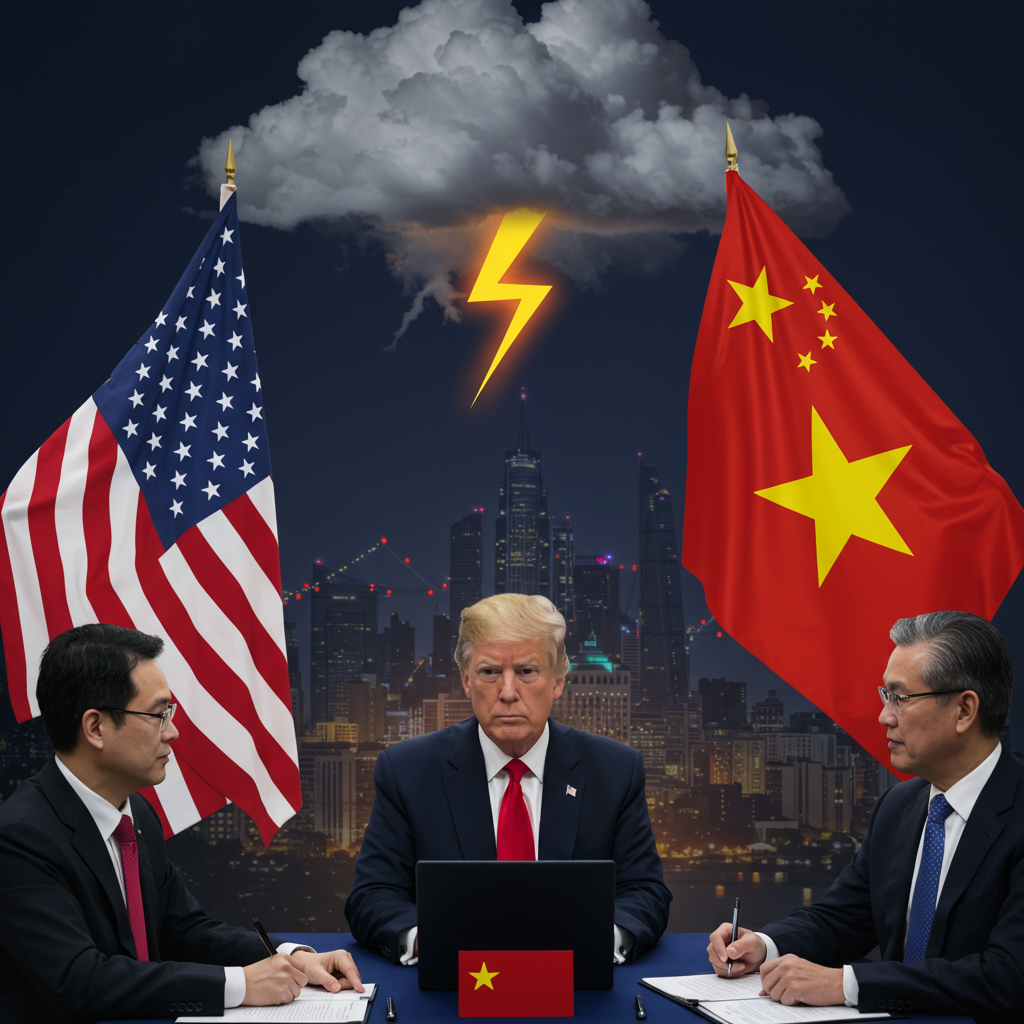A new trade agreement between the United States and vietnam is set to reshape economic ties, but it comes with a significant caveat. According to analysis from Bloomberg Economics, the terms of this deal, specifically targeting goods suspected of originating elsewhere, carry a substantial risk of provoking strong retaliatory measures from China. This development unfolds within a tense global trade environment marked by escalating tariff disputes led by the Trump administration.
A New Chapter in US-Vietnam Trade
The United States has officially reached a trade understanding with Vietnam. Announced just ahead of a critical July 9 deadline when previously paused tariffs were slated for increase, this preliminary agreement establishes new duty structures for goods flowing between the two nations. Under the terms, products imported from Vietnam into the US will generally face a 20% tariff rate. This figure is notably lower than the more punitive 46% tariff that had been floated earlier under the administration’s “Liberation Day” tariff proposals. However, it represents an increase from the current blanket 10% rate applying to many trading partners. Crucially, the deal includes a considerably higher 40% tariff specifically on goods identified as being transshipped through Vietnam. These are items originating from a third country, most notably China, attempting to evade existing US import duties by passing through Vietnam. In a reciprocal move, US goods exported to Vietnam are slated to face zero tariffs, effectively granting the US “TOTAL ACCESS” to the Vietnamese market, according to official statements. This signals a push to remove non-tariff barriers as well. This pact with Vietnam is the second significant trade deal announced by the US since pausing the broad high duties, following an agreement with the United Kingdom. It also coincides with a framework understanding recently established with China.
Vietnam’s Growing Trade Importance
Vietnam has rapidly become a vital player in the US trade landscape. It ranks as the 10th largest overall trade partner for the United States. It stands as the seventh-largest source of imports. Annually, over $130 billion worth of goods are sent from Vietnam to the US. Major American apparel companies like Nike and Lululemon maintain significant manufacturing facilities there. This burgeoning trade relationship has seen Vietnam’s trade surplus with the US expand dramatically. It ballooned to over $123 billion last year alone. Through April of the current year, the US trade deficit with Vietnam had already exceeded $50 billion. This shift is partly fueled by companies relocating manufacturing operations away from China. They are seeking to diversify supply chains amidst ongoing US-China trade tensions. Reports also suggest the US is exploring a tariff mechanism with Vietnam that could potentially adjust rates based on the percentage of foreign content found in manufactured goods.
The Transshipment Tariff and China Risk
The imposition of a steep 40% tariff on transshipped goods is a direct strategic measure. It is designed to prevent countries, specifically China, from circumventing US tariffs. China has historically utilized other nations to relabel or reroute products. This allows them to avoid paying duties applied directly to Chinese exports. Vietnam itself has reportedly taken steps to crack down on such practices. These actions are potentially aimed at currying favor with the United States amidst the trade disputes. However, this targeted tariff within the Vietnam deal introduces a significant risk. Bloomberg Economics highlights this clause as particularly provocative. Given China’s demonstrated pattern of robust retaliation against perceived trade aggressions, this anti-circumvention measure is highly likely to trigger a negative response from Beijing.
China’s Pattern of Retaliation
China’s reaction to US tariff actions has been consistent and aggressive. Following recent US tariff hikes, China quickly announced corresponding increases. They raised total tariffs on US goods to levels experts deemed commercially non-viable for US exporters. China’s Commerce Ministry has criticized the US approach as a “numbers game” and “destructive behavior.” Chinese President Xi Jinping has actively sought to build alliances. He urged the European Union to join forces against “unilateral bullying” from the US and uphold free trade principles. Beijing has shown a willingness to implement not only tariffs but also non-tariff barriers. This includes import bans on specific US facilities or products. Their strategy appears to be a long game. China seems prepared to absorb short-term pain. The goal is to wait for tariffs to inflict sufficient economic hardship on the US. This could eventually pressure the US administration to alter its policy.
Broader Global Trade Tensions Context
The US-Vietnam deal doesn’t exist in a vacuum. It is a component of the Trump administration’s broader, aggressive trade policy characterized by widespread use of tariffs. While the Vietnam deal offers a specific bilateral outcome, the general landscape remains volatile. Negotiations with other major partners like Japan have reportedly soured. Trump has threatened tariffs of 30%, 35%, or even higher on Japanese goods. He described Japan as “very tough” and “very spoiled.” The European Union has signaled willingness to accept a 10% universal tariff on many exports. However, they are seeking key sector exemptions (pharmaceuticals, alcohol, semiconductors, aircraft). The EU has taken a firmer stance. They insist the US must immediately remove existing tariffs as part of any framework deal. Talks with Canada have resumed following Trump’s threats to halt them. Canada recently withdrew a planned digital services tax targeting large US tech firms. This dynamic global environment means actions taken with one partner, like Vietnam, can have ripple effects on negotiations and relationships with others.
Significant Economic Repercussions
The widespread use of tariffs, including the structures seen in the Vietnam deal and the higher levels targeting China, carries substantial economic costs. Analysis by the JP Morgan Institute suggests that the current tariff plans could impose direct costs exceeding $82 billion on US employers. This could potentially lead to price increases for consumers. Businesses might face layoffs or hiring freezes. Profit margins could be squeezed. The US manufacturing sector has reportedly remained weak. Low new orders and rising input costs hinder business planning. Companies across various sectors are feeling the pinch. Electric vehicle maker Rivian reported decreased deliveries. They cited tariff-driven economic uncertainty among other factors. Businesses heavily reliant on imports, particularly from China, face steep challenges. One company importing specific products from China reported facing a staggering 145% tariff. They found domestic US manufacturing prohibitively expensive. Estimates suggest a 10% US tariff could jeopardize billions in exports and thousands of jobs in countries like Italy. Tariff pressures are also cited as dampening investor sentiment, particularly in Asian stock markets.
Hardship for the US Agricultural Sector
US farmers are particularly vulnerable in this trade climate. Agriculture is a major export sector. China was a market worth approximately $27 billion in 2024 for US agricultural products. China’s retaliation has included imposing sweeping tariffs on US farm goods, estimated around 34% overall. The tariff on soybeans, a critical export, has been raised to 60%, double the peak during the 2018 trade war. The American Soybean Association estimates this could cost farmers $5.9 billion annually. This situation directly benefits competitors like Brazil. Other commodities like cotton, sorghum, beef, pork, and seafood are also targeted. China has also implemented non-tariff barriers. They include import bans on specific US facilities citing health concerns, impacting sectors like poultry. Commodities markets react negatively, with soybean and cattle futures dropping. Shares of major agricultural companies have fallen significantly. Analysts warn that the broad nature of these tariffs makes it difficult for farmers to find alternative export markets. This leads to falling commodity prices and squeezed profit margins. The US agricultural sector’s high reliance on exports to Mexico, Canada, and China makes it especially susceptible. Furthermore, tariffs on agricultural imports from Mexico and Canada could contribute to higher food prices for US consumers.
Tariffs Complicate Monetary Policy
The ongoing trade disputes and resulting tariff uncertainty are also influencing domestic monetary policy. Federal Reserve Chair Jerome Powell has indicated that tariffs are a significant factor in the central bank’s decisions. He stated the Fed likely would have cut interest rates more aggressively. This was held back because tariffs materially raised inflation forecasts for the US. Powell noted that while the US economy is healthy overall, he expects the effects of tariffs to become more apparent in upcoming economic data. Despite facing pressure to lower rates, Powell stated the Fed went “on hold” partly due to the scale of the tariffs. Economists are divided on the Fed’s future response. Some believe tariff-induced inflation will delay rate cuts. Others argue the economic drag could force earlier easing. The situation creates a complex challenge for central bankers trying to balance inflation risks against slowing growth pressures.
Frequently Asked Questions
What are the main tariff rates in the new US-Vietnam trade deal?
The new agreement sets a 20% tariff on Vietnamese goods imported into the United States. However, a significantly higher tariff of 40% will apply to goods identified as being transshipped through Vietnam, primarily targeting products originating from countries like China that seek to avoid existing US duties. In return, US exports to Vietnam will face zero tariffs, opening their market fully.
Why would China potentially retaliate against the US-Vietnam trade deal?
China might retaliate specifically due to the 40% transshipment tariff included in the deal. This measure is designed to prevent Chinese goods from circumventing US tariffs by passing through Vietnam. China views such anti-circumvention efforts as part of the US’s broader, aggressive tariff strategy. Based on past actions, China is likely to respond by increasing its own tariffs on US goods or implementing other trade restrictions in kind.
How do US tariffs like those in the Vietnam deal impact the broader US economy or specific industries?
US tariffs contribute to increased costs for businesses relying on imports, potentially leading to higher prices for consumers, reduced profit margins, and even layoffs. Industries like US agriculture are particularly hard hit, facing retaliatory tariffs from countries like China that significantly reduce export markets and lower commodity prices. Economists warn these tariffs can raise inflation forecasts and complicate monetary policy decisions, potentially slowing overall economic growth.
Conclusion
The new trade deal between the United States and Vietnam marks a strategic shift in bilateral relations. While setting new tariff levels and opening the Vietnamese market to US goods, the inclusion of a stringent 40% tariff on transshipped items introduces a significant geopolitical and economic risk. As highlighted by Bloomberg Economics and consistent with recent trade patterns, this measure is likely perceived in Beijing as a direct challenge to its efforts to navigate existing US import duties. Consequently, the potential for robust Chinese retaliation is high. This specific bilateral agreement underscores the complex and often volatile nature of the current global trade landscape, where tariff policies designed to reshape trade balances can trigger chain reactions, impacting markets, industries, and economic forecasts worldwide.




